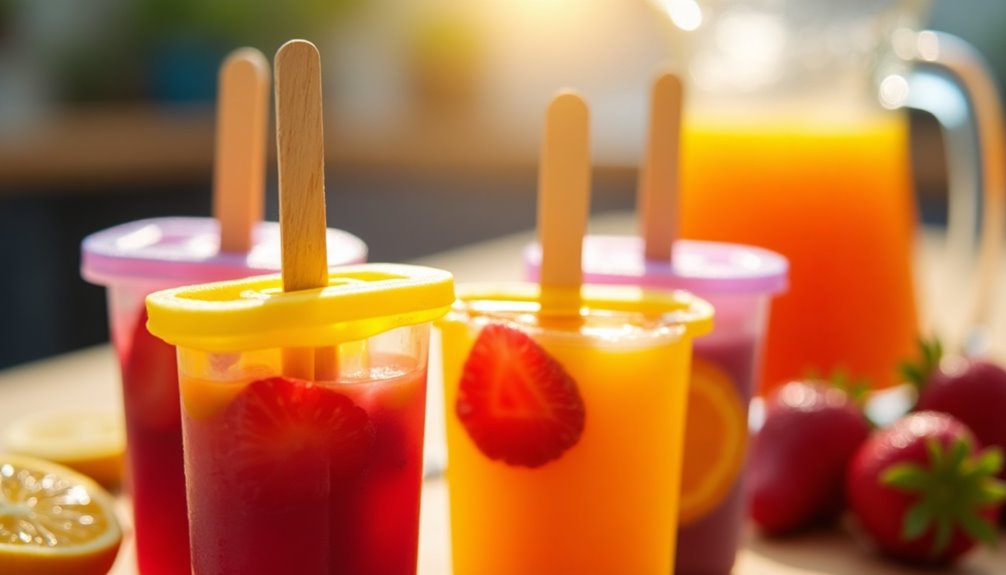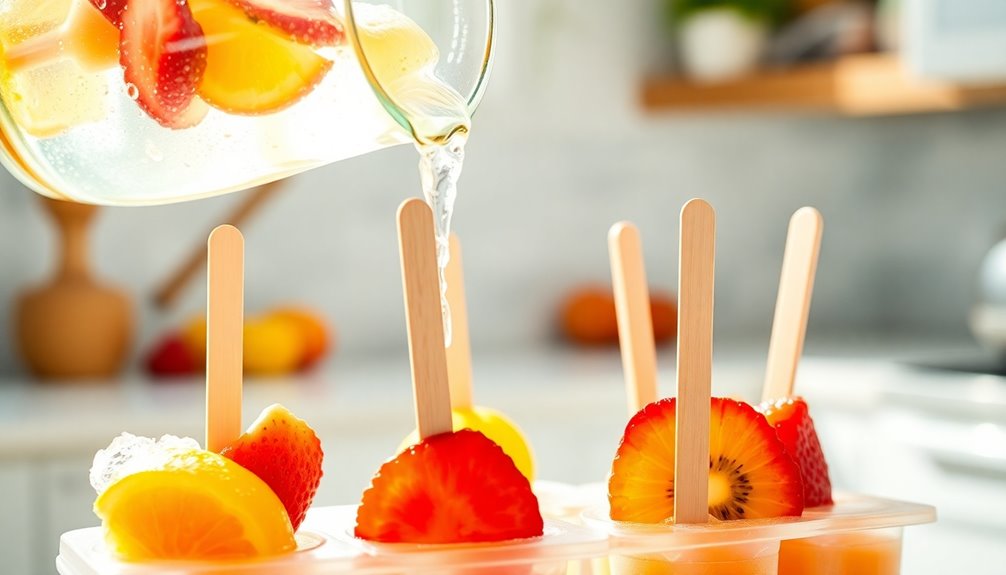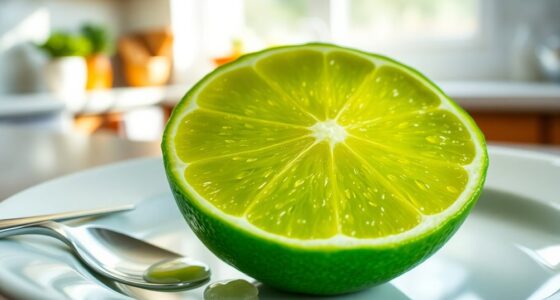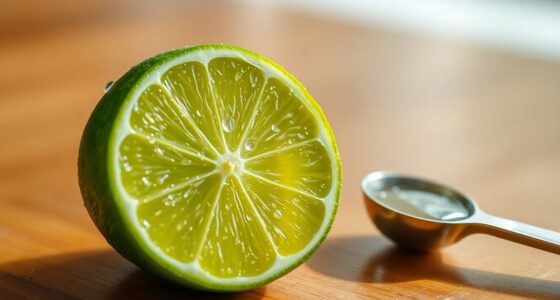Making popsicles with juice is easy and fun! Start by mixing your choice of 100% fruit juices, like orange or mixed berry, and chop up some fresh fruits for added flavor. Pour the juice mixture into molds, leaving a little space at the top, then insert sticks and freeze for 4-6 hours. When they're ready, run warm water over the molds to pop them out. Enjoy your tasty treats, and there's more to explore about customizing them!
Key Takeaways
- Choose a variety of 100% fruit juices and combine flavors for a unique popsicle base.
- Chop fresh fruits and mix them into the juice for added texture and flavor.
- Fill popsicle molds with the juice mixture, leaving a small gap for expansion.
- Freeze molds for at least 4-6 hours or overnight for best results.
- Remove popsicles by running warm water over the molds for easy release.

Making popsicles with juice is a fun and easy way to beat the heat while enjoying a refreshing treat. You can customize these homemade popsicles to suit your taste by choosing from a variety of 100% fruit juices or even combining different flavors. Think about using classic options like orange or pineapple juice, or mix it up with something adventurous like mixed berries. The best part? You can ensure that your popsicles are packed with nutrients and free from artificial additives, making them a healthier choice compared to store-bought options.
To get started, gather your ingredients and popsicle molds. If you want to elevate your treats, consider adding fresh fruit pieces to the juice—this not only enhances the flavor but also adds a lovely visual appeal. You can chop up strawberries, blueberries, or any seasonal fruit you enjoy and mix them right into your juice. If you're feeling tropical, using coconut water as a base can give your popsicles a refreshing twist. Alternatively, a splash of lemon juice can be mixed in for a zesty kick.
Once you’ve decided on your juice and any additional ingredients, it’s time to pour the mixture into the popsicle molds. Fill each mold, but remember to leave a small gap at the top. This is crucial because as the juice freezes, it will expand. After you’ve filled the molds, insert popsicle sticks into the center of each one. Make sure they’re positioned evenly so that your popsicles freeze uniformly. Once you’ve filled the molds and inserted the popsicle sticks, carefully place them in the freezer. It’s best to let them freeze for at least 4-6 hours or until they are completely solid. If you’re interested in exploring other ways to enhance your popsicle creations, you might look up how to increase pp size juice for a richer flavor or to incorporate more nutrients. Enjoy your refreshing homemade treats as a delightful snack on a hot day!
Now, pop your molds into the freezer and let them chill for at least 4-6 hours or overnight. Patience is key here; the longer you wait, the more solid and satisfying your popsicles will be.
When you're ready to enjoy your homemade popsicles, take them out of the freezer. If they're stuck in the molds, don't worry! Just run warm water over the outside of the molds for about 8-10 seconds. This will help loosen them up. Gently push from the bottom of the molds, and you'll have beautifully formed popsicles ready to eat.
These popsicles aren't only delicious but also a great way to incorporate healthy ingredients into your diet. By using natural sweeteners like honey or maple syrup, if you prefer, you can control the sweetness of your treats. You can even use frozen fruit as a base for your juice if you want to create a thicker consistency.
Frequently Asked Questions
What Is the Best Juice to Freeze for Popsicles?
When you're choosing the best juice to freeze for popsicles, go for 100% pure juices without added sugars.
Orange, mango, and apple juices pack vibrant flavors and natural sweetness. If you want something refreshing, freshly squeezed watermelon or pineapple juice is perfect for hot days.
Mixing citrus juices like lemon with sweeter ones can balance flavors.
Don't forget to experiment with vegetable juices or herbal infusions for unique, adult-friendly options!
How to Make Popsicles With Juice Without Molds?
You can easily make popsicles without molds by using small plastic or paper cups. Just pour your juice into the cups, filling them about three-quarters full.
Insert a popsicle stick into the center before freezing for 4 to 6 hours. Once solid, run warm water over the outside of the cups for about 10 seconds to release your popsicles.
Enjoy them directly from the cups or peel off the cup for a fun treat!
How to Make Slush Popsicles?
To make slush popsicles, you'll blend your favorite fruit juice with ice until it reaches a slushy consistency.
If you want a smoother texture, add a splash of lemon juice or honey.
Pour the mixture into molds, leaving a little space at the top for expansion. Insert the sticks and freeze for 4-6 hours or until solid.
When you're ready to enjoy them, run the molds under warm water to unmold easily.
How Do You Make Juice Popsicles Softer?
To make your popsicles softer, you can add lemon juice for a smoother freeze, mix in Greek yogurt for creaminess, or dilute sweet juice concentrate with water.
You'll want to freeze them for just 3-4 hours instead of the usual time, keeping that delightful texture intact.
Experiment with fruit purees or coconut water to boost flavor and softness.
With these tips, you'll enjoy a refreshing treat that's easy to savor!
Conclusion
So, there you have it—making popsicles with juice is a breeze! You might think these frozen treats are just for hot summer days, but they can be a refreshing reminder that life's simple pleasures often come from the most basic ingredients. While you're busy savoring your homemade popsicles, just remember: sometimes the sweetest moments come from blending together what you already have, proving that even in the simplest tasks, there's a deeper joy waiting to be discovered.
Cindy thoroughly researches juicing trends, techniques, and recipes to provide readers with practical advice and inspiration. Her writing style is accessible, engaging, and designed to make complex concepts easy to understand. Cindy’s dedication to promoting the advantages of juicing shines through her work, empowering readers to make positive changes in their lives through the simple act of juicing.











